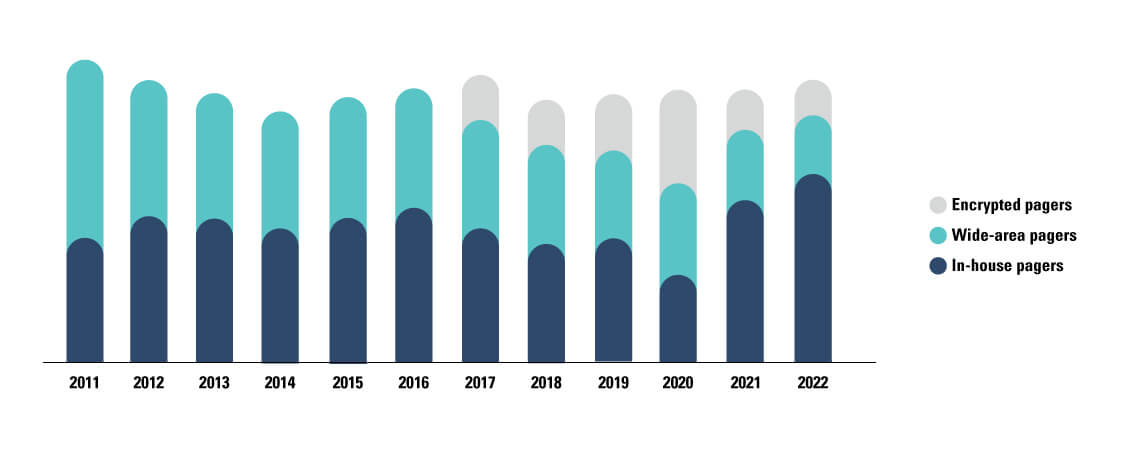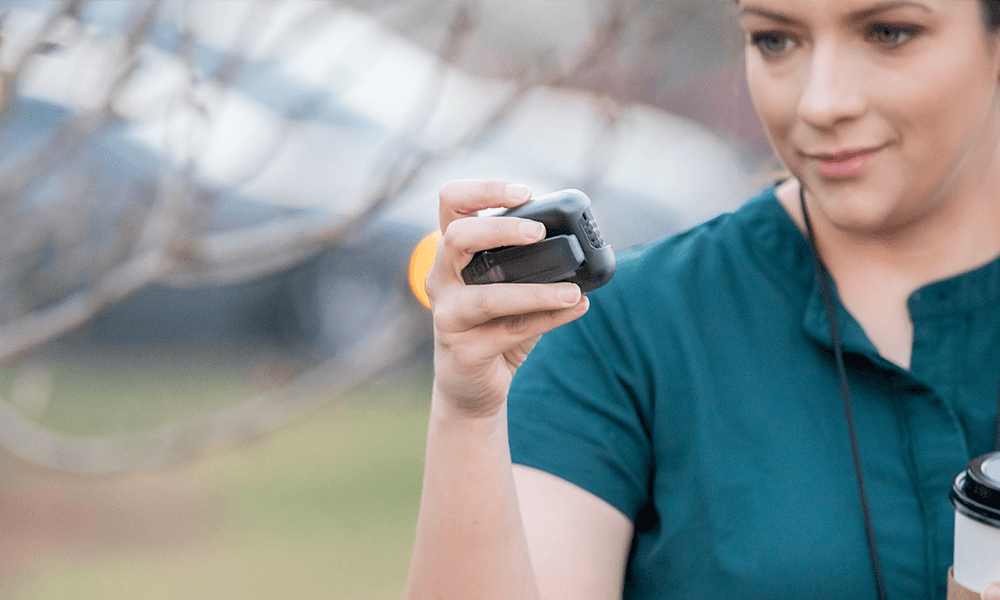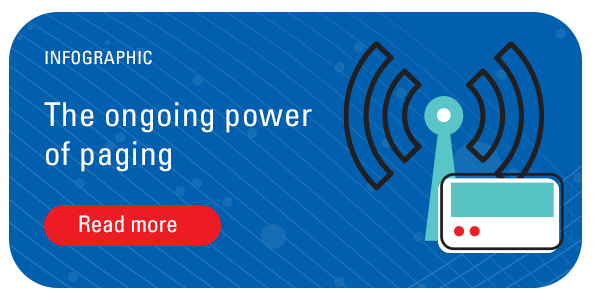Paging technology shines in disaster situations due to its reliability and independent power source, allowing healthcare workers to send and receive critical communications when Wi-Fi and cellular networks are down. Paging architecture utilizes overlapping coverage, height and power advantages, satellite connections, and redundancy to ensure service continuity and reliability.
Pagers, though often seen as "old technology," continue to play a crucial role in healthcare communications, alongside smartphones and other devices. Encrypted pagers are now available, meeting HIPAA compliance requirements in sensitive environments. Despite the emergence of new devices, leading hospitals maintain their paging systems due to the reliability, simplicity, and longevity that physicians, nurses, and nonclinical care team members value.
Let's delve into the technologies involved and how they facilitate important patient care activities.
What is a paging network?
Paging networks can be classified as wide-area or on-site. Wide-area paging employs transmitter towers that cover a large area, while on-site paging works within a specific campus environment, functioning as a standalone system.
The popularity of pagers
Hospitals and health systems have consistently supported additional devices since 2011, with smartphones being the top choice since 2012. However, pagers have shown ongoing relevance, especially with the introduction of encrypted pagers in 2016.

Webinar: The future of paging - How to improve critical communication with Spok >>
5 Reasons why healthcare organizations value pagers
1. Pagers support a powerful device diversity approach and complement secure text messaging
Healthcare systems integrate pagers into their workflows alongside smartphones to achieve a powerful "device diversity" approach. Effective communication requires the ability to send messages to different staff members on their preferred devices. Pagers and smartphones can work together, receiving alerts from various systems, ensuring seamless communication.
Clinical use case for paging: Eli’s care team determines he is experiencing a heart attack and operator staff launch a code STEMI. Notifications, including the patient location, are automatically sent to the code team, some of whom use smartphones, some who use pagers, and others Wi-Fi phones.
The operator uses an emergency notification system to deploy a single message, which reaches everyone on the right device. The code team rallies, and the balloon procedure is started quickly, supporting improved patient outcomes.
.jpg?width=1667&height=521&name=STEMI-Multi-Device-Workflow%20(1).jpg)
Certain secure texting apps support crucial healthcare communication by seamlessly integrating with the hospital’s directory and on-call information. Smartphones and pagers can collaborate effectively, as they can both receive alerts from patient monitoring, nurse call systems, and other communication platforms. When hospitals assess communication technologies, it is essential to prioritize finding a partner capable of sending messages to a diverse range of devices.
2. Not everyone needs a smartphone to do their job
Not all healthcare professionals need smartphones for their roles. Nonclinical team members, such as housekeepers and transport technicians, can benefit from inexpensive pagers that fulfill their communication needs. Ensuring a communication system that caters to all team members, regardless of their devices, supports effective care coordination.
3. Encrypted paging supports HIPAA compliance
Encrypted pagers offer secure communication, previously available only on smartphones equipped with secure texting apps. They ensure reliable communication, even in areas with limited cellular or Wi-Fi coverage, easing the secure sharing of protected health information (PHI).
4. Paging is reliable and cost-effective
Pagers are simple, reliable, and cost-effective, making them invaluable for critical messaging. They are not affected by lapses in cellular or Wi-Fi coverage, and their replacement cost is negligible compared to smartphones.
In fact, maintaining a pager for just a few pennies a day ensures its availability whenever needed. Paging is still unparalleled in terms of cost-effectiveness. If a pager is lost, replacing it is not a concern, unlike the potential consequences of losing a smartphone.
5. Nothing beats paging in disaster situations
We can’t predict when disasters will strike, but we can lay the groundwork that will give critical communications the best chance of getting through when almost nothing else can. And that is done only through the reliability and survivability of paging technology.
Most hospitals have defined procedures for disaster response. Paging technology shines in disaster situations. With their demonstrated reliability and independent power source, pagers ensure healthcare workers can send and receive critical communications even when Wi-Fi and cellular networks are down.
The science behind paging’s survivable architecture
Many organizations now need business case support for new technology, products, or investments. In recent years, smartphones and tablets have become integral to clinical communications. Yet even today, no mobile communication technology is more reliable, survivable, and affordable than the pager. Surprisingly, few understand why paging is still relevant today.
4 things to know about paging architecture
1. Overlapping coverage:
Paging networks offer redundant wireless coverage for mission-critical users. As emergency events often involve physical damage to property (including wireless transmitters), having overlapping coverage is critical for continuation of service. By simultaneously broadcasting messages from multiple towers in a coverage zone, pagers can communicate with multiple towers at once. This ensures service continuity even if one tower fails, unlike cellular networks.
2. Height and power
Paging transmitters are elevated up to 300 feet and employ high power, resulting in superior coverage both indoors and across larger areas. With an Effective Radiated Power (ERP) of up to 3,500 watts, paging transmissions outperform cellular transmissions (approximately 100 watts).
3. Satellite connection
Paging networks use satellite connections between the core messaging network and transmitter towers. Satellite links eliminate terrestrial points of failure. Terrestrial points of failure refer to vulnerable locations or components within a terrestrial (land-based) network infrastructure that can lead to disruptions or failures in the overall system. These points are susceptible to various factors such as natural disasters, physical damage, equipment failures, or deliberate attacks. In addition, many satellite dishes are at ground level or on building rooftops, making them easy to access if technicians need to make repairs.4. Redundancy
Paging providers implement fully redundant infrastructure, including WAN/LAN diversity, messaging switches, power sources, and satellite uplinks. This redundancy enhances operational continuity and adds an extra layer of reliability to the network systems.Conclusion: Embracing device diversity
Pagers continue to hold significant value in healthcare communications, coexisting alongside smartphones and other devices. Leading hospitals recognize the value of integrating encrypted pagers with smartphones to maximize communication benefits and coverage. The reliable and cost-effective nature of pagers proves valuable not only for roles that don't require smartphones but also during emergencies when other communication methods may fail. A flexible and device-agnostic communications infrastructure supports swift care coordination and enhances patient outcomes.
Overall, pagers continue to be an integral part of healthcare communication, offering reliability, simplicity, and cost-effectiveness in critical messaging and ensuring effective care coordination, especially in situations where other communication technologies may falter.


